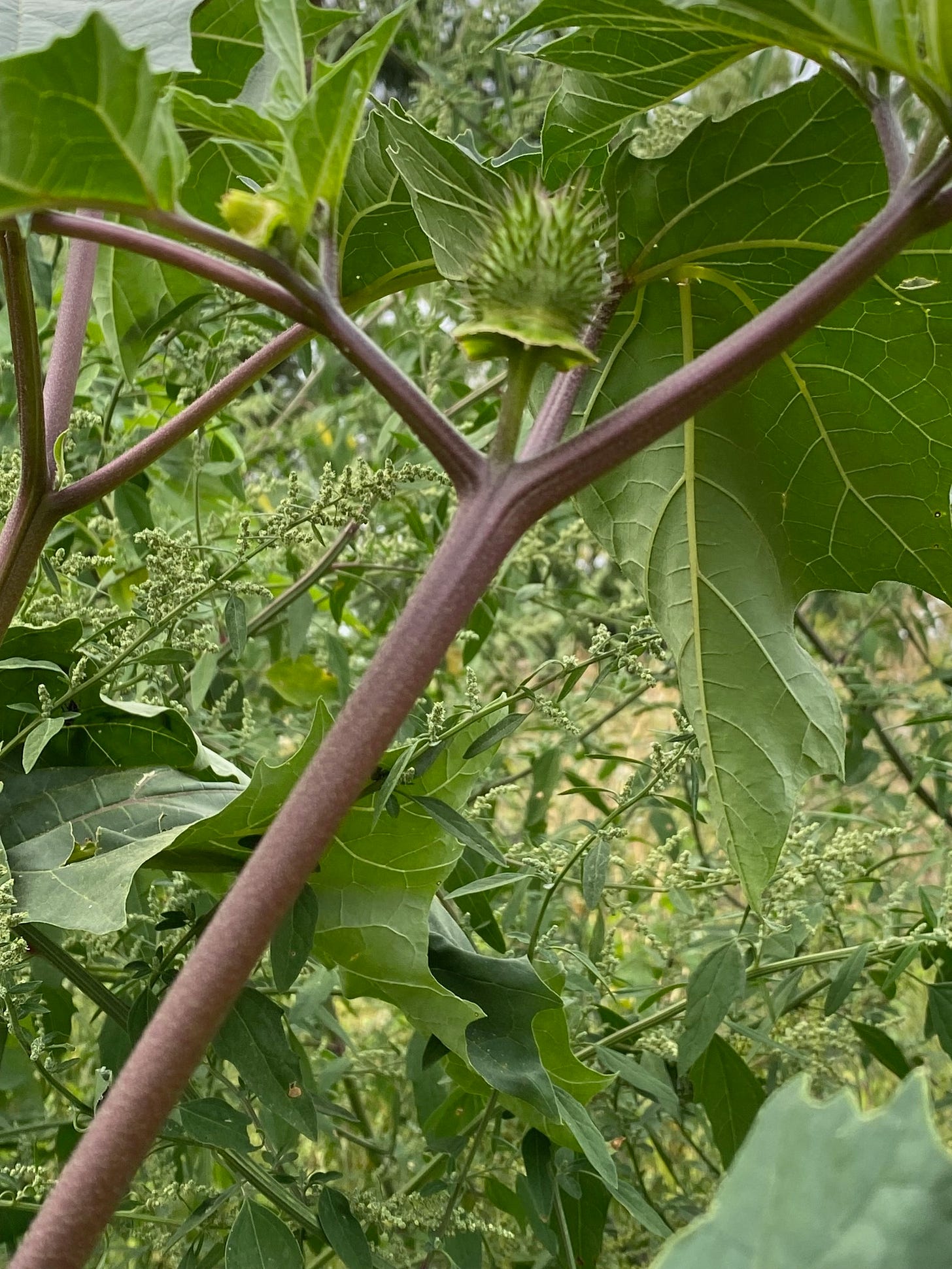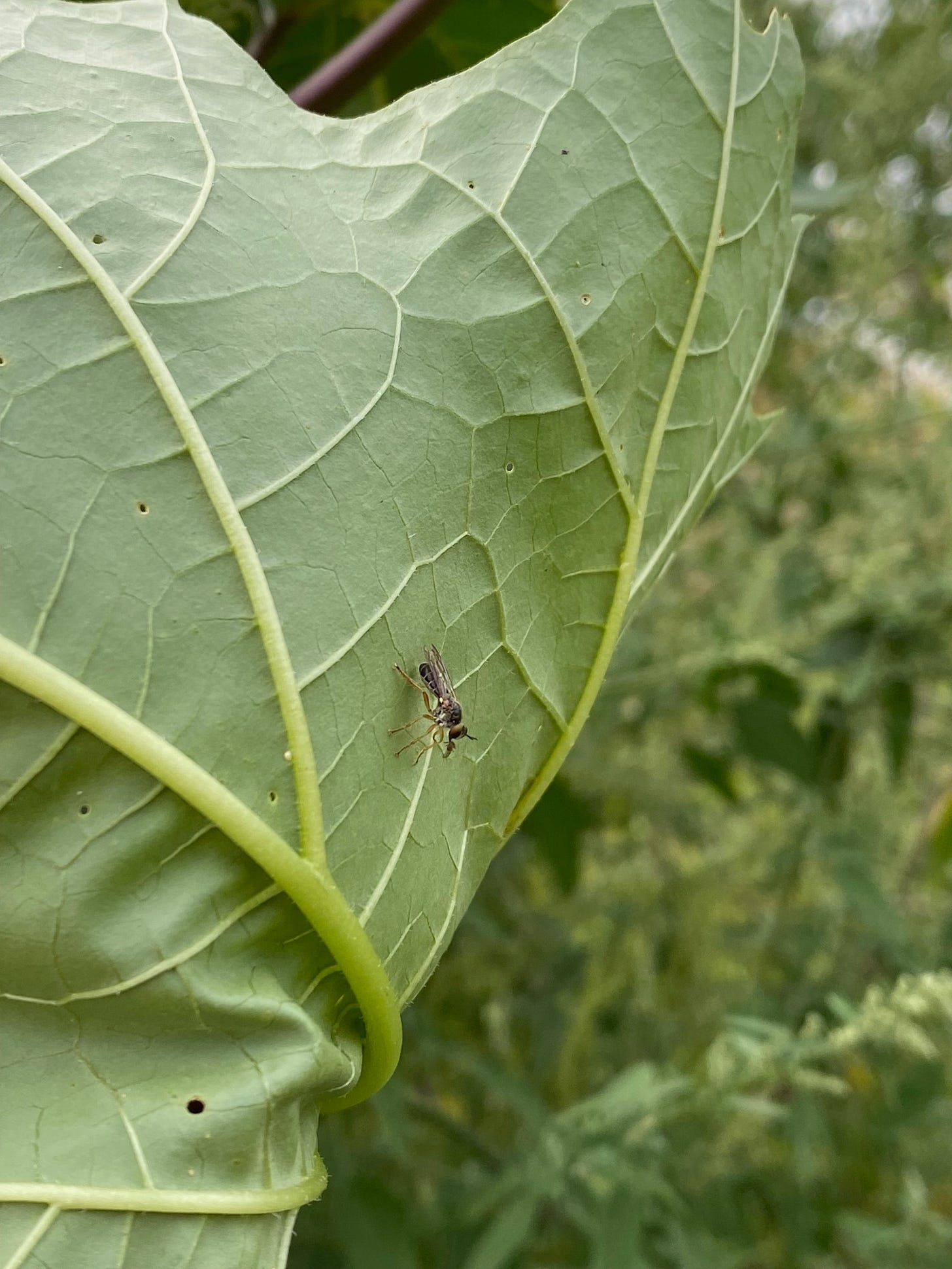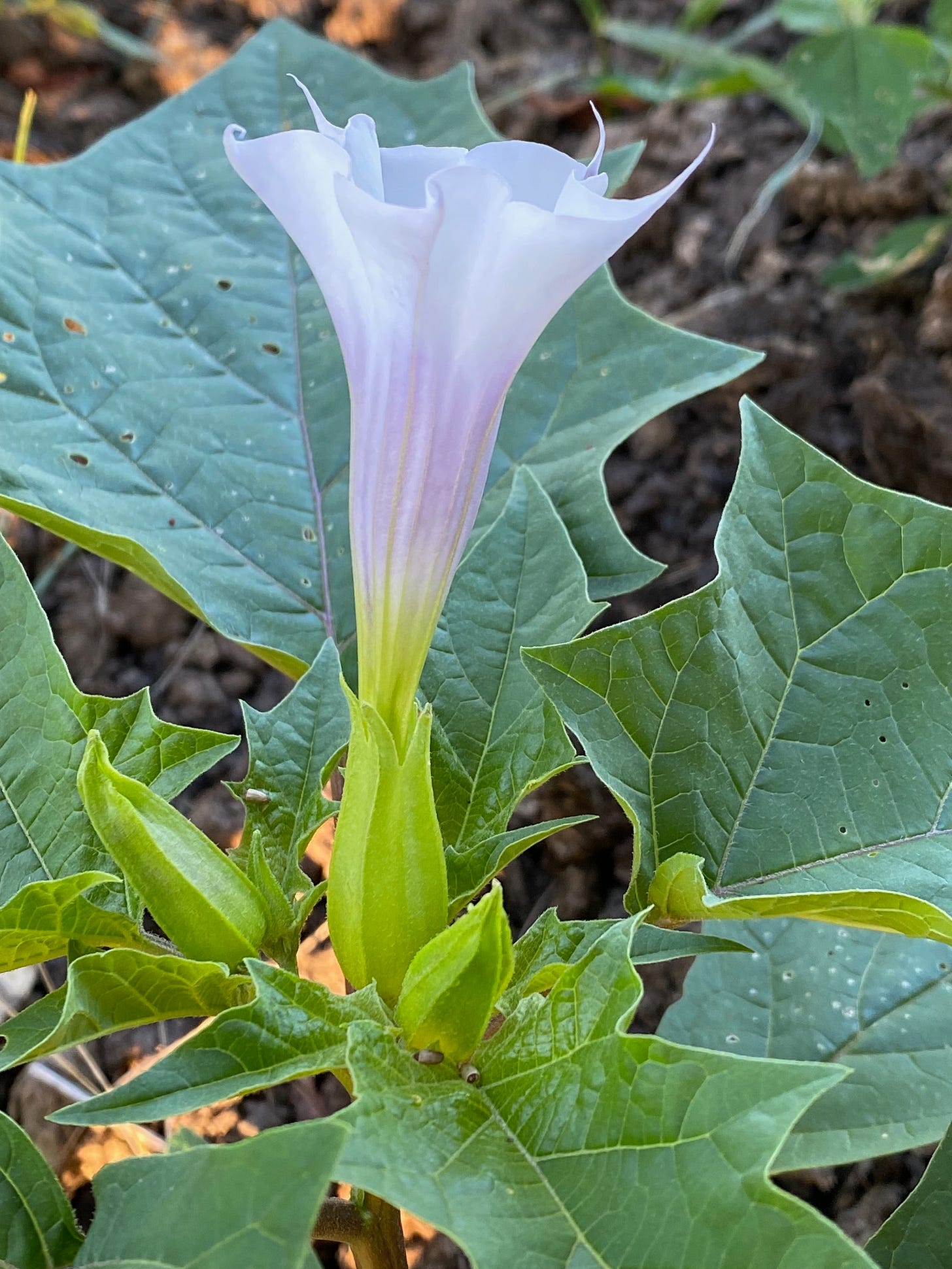Jimson Weed
Using this weed, it’s very possible to take a trip without leaving the farm. At weedom, we don’t like to leave reality so much, so we can’t tell you from personal experience about Jimson Weed Journeys. Likewise, our bovine neighbors are not fond of the smell and taste of this plant, so they remain staid, stoic, and standing on all four legs. People at Erowid.org can tell you all about the hallucinogens, however, and it’s definitely worth a look to see how this weed affects those who try it. Determining how many seeds or leaves are too much is the great challenge, and this is a fairly individual issue. If your anticholinergic trip transports you to outer space, your friends might have to dial 911, and have your body sent to the emergency room to wait for your return. During this time the tropane alkaloid constituents of this weed can cause cardiac arrhythmias, hyperthermia, dry mouth and red skin, mydriasis (dilated pupils) retention of urine that requires catheterization, slowing of bowel activity, seizures, and various other issues that tend to cause quite a bit of panic. Keep in mind that your body has acetylcholine receptors (of muscarinic variety) from the top of your head to the tips of your toes, and this is why effects of jimson weed’s tropane alkaloids are so extensive.
The hallucinations associated with Datura’s effects upon the brain fall mostly into the category of delirium, due to their mechanism of action, and the nature of the person’s response to the experience. Here’s a rapid recap of hallucinogens:
Psychedelics such as LSD and certain magic mushrooms mostly affect the serotonin receptors, a chiefly affected on being 5HT-2A. They tend to give the most vivid, altered sensory experiences of external surroundings.
The dissociative hallucinogens such as ketamine antagonize the NMDA (N-Methyl-D-aspartate) receptor, and tend to make you feel as though you have left your body or are separated from it and the environment.
The deliriants will seem to alter your external reality, and you might be more totally convinced that the alteration is real, and therefore more likely to respond to it as real. These effects and responses can negatively affect the user, particularly if the environment or associates are not ideal, so these drugs are not as popular recreationally. However the use of Datura species probably goes back further than most other types of hallucinogens, and they might even be next oldest psychoactive substance after alcohol.
Though many people have been tripping out on Datura stramonium, and closely related weeds, there have been relatively low numbers of deaths blamed on them. Tropane alkaloids within this plant, which have the capability of crossing the blood brain barrier, are responsible for both the deliriant effects sought by users, as well as untoward peripheral effects. There are known benefits too, such as bronchodilation, which assists asthma sufferers, and general antispasmodic effects. The leaves or roots of the plant were smoked to address the bronchoconstriction and hyper secretory symptoms of asthma. Small doses of scopolamine and atropine / hyoscyamine, which are constituents of Jimson weed, are well used in medical practice. Atropine is a racemic mix 50/50 of the isomers of hyoscyamine. The L(-) isomer has been marketed as Levsin, hyoscyamine sulfate. This isomer is unstable and tends to revert back to the racemic mixture.
To get you thinking about food, Jimson weed belongs to the Solanaceae, the nightshade family, to which your eggplants, potatoes, peppers, and tomatoes also belong. There are special compounds in everything we eat. It’s all about dose.
At weedom-land there is a LOT of Jimson weed, Datura stramonium, and it abounds throughout the U.S. and at least 100 other countries. Also scattered across much of the U.S. is Datura wrightii, which can be distinguished from our weed by its larger size, more and finer spines on the seed pod, presence of hair on stems and leaves, and a tendency for the seed pods to droop a bit from their short stems. It also seems to have similar potency and effects. Seed pods of our Datura stramonium have fewer spines, and sit completely upright, as do the flowers. The stems of our weeds are hairless, and the leaves have very few hairs, prominent veins and a smooth, somewhat waxy feel on top and bottom. The leaf underside is a good deal lighter green than the top side. There is a prominent central vein, and secondary veins branch off in a sort of alternate pattern. Leaves are quite variable in size, but our plants can have leaves more than 8 inches long with many, somewhat irregular, pointed lobes. This is a weed which can tolerate heat and dry conditions, which is why we have been able to produce some decent, 2023 photos.
The blooms open in the evening or at night, but tend to close up tightly during the heat of the day. Flowers are trumpet shaped, formed by 5 fused petals, and emerge from a tubular, 5 pointed calyx. Flowers are about 10 cm in length and the fully open end of the trumpet is equally about 10 cm. (4 inches) in diameter. The interior of the flowers may have a prominent purple tinge.
The seed pod is ovoid, 4-5 cm (up to 2 inches) long, and not quite as wide. It turns from green to dark brown as it matures, and opens, showing 4 valves or chambers filled with numerous dark brown or black seeds.

The odor of Jimson weed is indescribable. We’ll go with funky. It’s not as terrible as rotting corpse, stinky feet or feces, but it IS totally unappetizing, and has inspired the moniker “stinkweed”.
For a change of pace, here’s a short list of where some of the same alkaloids found in Datura stramonium can be seen in regular medical use. Find atropine in eye drops, which have been used to dilate pupils for eye exams. With shorter acting tropicamide, and with modern instrumentation, this use has faded, and the drops are sometimes used for end of life care to reduce secretions. It is used intravenously in symptomatic bradycardia (slow heart rate), and as an additive to diphenoxylate, in the drug-for-diarrhea, Lomotil, to prevent abuse. Scopolamine, which most readily passes through the blood brain barrier, is found in those behind-the-ear, transdermal patches for motion sickness. Hyoscyamine is most prominently used orally as a treatment for gastrointestinal disorders and as an antispasmodic. We’ve gone around the world with routes of drug administration, and would not want to miss one: A similar array of these alkaloids, from belladonna, are used in a rectal suppository to relieve spasms and pain after prostate surgery.
Smoking Datura herbs seems to have entered the western world via Great Britain, in the form of dried roots of Datura ferox, a purple flowered species imported from India. Asthma attacks were addressed by smoking pulverized dried roots of this plant. This inspired the use of the related Datura stramonium, a local weed, and the roots and stems were found to be more acceptable, (perhaps since the leaves and seeds had been perceived as a toxic witch’s concoction). Smoking commercial products containing Datura stramonium along with other bronchodilators such as lobelia, and the anti-inflammatory cubeb pepper has continued into recent times, despite the harshness of this direct and rapid delivery system on the lung epithelium.
Jimson weed is full of useful compounds, in addition to the most well known tropane alkaloids. In various cultures it has been for wound care, to take advantage of antimicrobial activity. Nematicidal activity and cytotoxic activity have been detected. In Asian countries, topical use of Datura species was well established in traditional medicine. In Western literature, the toxicity of the whole family Solanaceae has been emphasized largely due to the long standing agenda to convince the public avoid hallucinogens. With the widespread resurgence of interest in hallucinatory plants to address depression, Datura species, for good or ill, are surely going to receive increased attention.
Where We Dig
1. Brugmansia (Angel’s Trumpet, Tree Daturas) | North Carolina Extension Gardener Plant Toolbox. Accessed October 3, 2023. https://plants.ces.ncsu.edu/plants/brugmansia/
2. Josh. Cubeb Pepper, a medicinal plant used for thousands of years. Healthy Hildegard. Published March 29, 2018. Accessed October 3, 2023. https://www.healthyhildegard.com/cubeb-pepper-piper-cubeba/
3. Datura innoxia (Angel’s Trumpet, Downy Thorn-Apple, Prickly Burr) | North Carolina Extension Gardener Plant Toolbox. Accessed October 3, 2023. https://plants.ces.ncsu.edu/plants/datura-innoxia/
4. Datura metel (Angel’s Trumpet, Death Angel, Devil’s Trumpet, Downy Thorn-apple, Hindu Datura, Horn of Plenty, Metel, Thorn-Apple) | North Carolina Extension Gardener Plant Toolbox. Accessed October 3, 2023. https://plants.ces.ncsu.edu/plants/datura-metel/
5. Robinson DW, Brown K, McMenemy M, et al. Datura quids at Pinwheel Cave, California, provide unambiguous confirmation of the ingestion of hallucinogens at a rock art site. Proc Natl Acad Sci U S A. 2020;117(49):31026-31037. doi:10.1073/pnas.2014529117
6. Datura stramonium (Datura, Jamestown Weed, Jimsonweed, Stinkweed, Thorn-apple) | North Carolina Extension Gardener Plant Toolbox. Accessed October 3, 2023. https://plants.ces.ncsu.edu/plants/datura-stramonium/
7. Datura stramonium (jimsonweed) | CABI Compendium. Accessed October 3, 2023. https://www.cabidigitallibrary.org/doi/10.1079/cabicompendium.18006
8. mukherjee singh O. Datura stramonium: An overview of its phytochemistry and pharmacognosy. Research J Pharmacognosy and Phytochemistry. 2013;5:143-148.
9. Datura wrightii (Angel’s Trumpet, Jimsonweed, Sacred Datura, Sacred Thorn-Apple, Thorn-Apple) | North Carolina Extension Gardener Plant Toolbox. Accessed October 3, 2023. https://plants.ces.ncsu.edu/plants/datura-wrightii/
10. Jakabová S, Vincze L, Farkas A, Kilár F, Boros B, Felinger A. Determination of tropane alkaloids atropine and scopolamine by liquid chromatography-mass spectrometry in plant organs of Datura species. J Chromatogr A. 2012;1232:295-301. doi:10.1016/j.chroma.2012.02.036
11. JACKSON M. “Divine Stramonium”: The Rise and Fall of Smoking for Asthma. Med Hist. 2010;54(2):171-194.
12. Erowid Datura Vault. Accessed October 3, 2023. https://www.erowid.org/plants/datura/datura.shtml
13. HerbalGram: JimsonWeed: History, Perceptions, Traditional Uses, and Potential Therapeutic Benefits of the Genus Datura. Accessed October 3, 2023. http://cms.herbalgram.org/herbalgram/issue69/article2930.html?ts=1696377025&signature=bbbf47c2791232df33a14a0df75e3e47&ts=1696377052&signature=59fe4b64ffe88671219e9511ba7d3ef6
14. Courtenay A de. Jimson Weed: Dangerous Magic. East West School of Planetary Herbology. Published August 7, 2019. Accessed October 3, 2023. https://planetherbs.com/blogs/lesleys-blog/jimson-weed-dangerous-magic/
15. Soni P, Siddiqui AA, Dwivedi J, Soni V. Pharmacological properties of Datura stramonium L. as a potential medicinal tree: An overview. Asian Pac J Trop Biomed. 2012;2(12):1002-1008. doi:10.1016/S2221-1691(13)60014-3
16. Kohnen-Johannsen KL, Kayser O. Tropane Alkaloids: Chemistry, Pharmacology, Biosynthesis and Production. Molecules. 2019;24(4):796. doi:10.3390/molecules24040796









Although it is very useful for asthma, I mainly use it topically. Jimson Weed is excellent for nerve used as a foot bath or soak. Horse nettle is similar but far less potent.
I want to get high on Jimson weed! I wonder if we have it here in Philadelphia. Where are you located, Weedom?